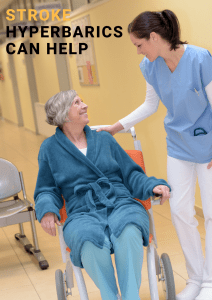
After suffering a stroke, about three-fourths of patients exhibit some disability. The extent of a patient’s symptoms depends on the degree and location of brain tissue damage following the stroke.
Common physical conditions after a stroke include:
- Weakness, paralysis, and problems with balance or coordination.
- Pain, numbness, or burning and tingling sensations.
- Fatigue, which may continue after you return home.
- Inattention to one side of the body, also known as neglect; in extreme cases, you may not be aware of your arm or leg.
- Urinary or bowel incontinence.
- Speech problems or difficulty understanding speech, reading, or writing.
- Difficulty swallowing.
- Memory problems, poor attention span, or difficulty solving problems.
- Visual problems.
- Depression, anxiety, or mood swings with emotional outbursts.
- Difficulty recognizing limitations caused by the stroke.
Through the use of hyperbaric oxygen therapy, medical researchers have found a way to restore a significant amount of neurological function in brain tissue thought to be chronically damaged by stroke, traumatic injury, and metabolic disorder — even years after the original injury. Some physicians in the US prescribe hyperbaric oxygen therapy (HBOT) in addition to traditional post-stroke therapies, although clinicians in other countries are more aggressive in their use of HBOT for stroke.
In the 1990s HBOT pioneers like Dr. Paul Harch and Dr. Richard Neubauer began successfully treating a vast range of brain injuries with hyperbaric oxygen. Eventually, this experience in humans with chronic brain injuries was duplicated in an animal model that was published by Dr. Harch in October 2007 (Brain Research, 2007; 1174:120‐9). In the history of hyperbaric medicine over 30 animal studies and 25-30 human studies have been published on HBOT in stroke. Results are overwhelmingly positive.
A recent human study conducted by Dr. Shai Efrati of Tel Aviv University’s Sackler Faculty of Medicine has proven positive results in a more “clinically approved”, prospective, randomized, controlled trial. They found that the neurological functions and life quality of all patients receiving HBOT were significantly improved following the HBOT sessions.
The results indicate that HBOT can lead to significant neurological improvements in post-stroke patients even at chronic late stages – years after initial injury.
“We provide, for the first time, convincing results demonstrating that HBOT can induce significant neurological improvement in post stroke patients,” write the study’s authors. “The neurological improvements in a chronic late stage demonstrate that neuroplasticity can be operative and activated by HBOT even long after acute brain insult,” they add.
You can read more about this study here (http://journals.plos.org/plosone/article?id=10.1371/journal.pone.0053716) or here (https://www.sciencedaily.com/releases/2013/01/130123144218.htm)
For stroke patients, HBOT’s typical results are:
- Faster Overall Recovery
- Improved Vision and Speech
- Reduced Paralysis
- Accelerated Gross/Fine Motor Skills Recovery
- Increased Brain Tissue Recovery
- Stimulated Creation of Blood Vessels (to Reclaim Damaged Brain Tissue)
- Creation of New Brain Cells
- Creation of New Brain Connections
- Alleviated Spasticity
If you’re still experiencing the effects of stroke and no longer seeing improvement in symptoms, consider HBOT.
The experts at Hyperbaric Oxygen Therapy of Western New York can answer your questions and address any concerns you may have. Visit us at www.02wny.com or call us: (585) 426-8969

Recent Comments